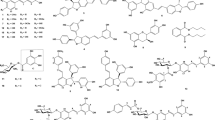Abstract
In the course of finding Korean natural products for acetylcholinesterase (AChE) inhibitory activity, we found that a methanolic extract of the roots ofAngelica dahurica showed significant inhibitory effects on AChE. Bioassay-guided fractionation of the methanolic extract resulted in the isolation of three furanocoumarins, isoimperatorin (1), imperatorin (2) and oxypeucedanin (3), as active principles. These compounds inhibited AChE activity in a dose-dependent manner, and the IC50 values of compounds1–3 were 74.6, 63.7 and 89.1 uM, respectively.
Similar content being viewed by others
References
Bartus, R. T., On neurodegenerative diseases, models, and treatment strategies: lessons learned and lessons forgotten a generation following the cholinergic hypothesis.Exp. Neurol., 163, 495–529 (2000).
Bartus, R. T., Dean, R. L., Beer, B., and Lippa, A. S., The cholinergic hypothesis of geriatric memory dysfunction.Science, 217, 408–414 (1982).
Baek, N. I., Ahn, E. M., Kim H. Y., and Park, Y. D., Furanocoum-arins from the root o.Angelica dahurica.Arch. Pharm. Res., 23, 467–470 (2000).
Broadwell, R. D., and Sofroniew, M. V., Serum proteins bypass the blood-brain fluid barriers for extracellular entry to the central nervous system.Exp. Neurol. 120, 245–263 (1993).
Cho, J. Y., Lee, J. S., Park, J. S., and Park, M. H., Isolation of inhibitory componints on tumor necrosis factor-production fro.Angelica koreana.Yakhak Hoeji, 42, 125–131 (1998).
Chung, Y. K., Heo, H. J., Kim, E. K., Kim, H. K., Huh, T. L., Lim, Y., Kim, S. K., and Shin, D. H., Inhibitory effect of ursolic acid purified fro.Origanum majorana L. on the acetylcholinesterse.Mol. Cells, 11, 137–143 (2001).
Ellman, G. L., Courtney, D., Valentino, A., and Featherstone, R. M., A new and rapid colorimetric determination of acetyl-cholinesterase activity.Biochem. Pharmacol., 7, 88–95 (1961).
Hwang, S. Y., Chang, Y. P., Byun, S. J., Jeon, M. H., and Kim, Y. C., An acetylcholinesterase inhibitor isolated from Corydalis Tuber and its mode of action.Kor. J. Pharmacogn., 27, 91–95 (1996).
Kim, S. H., Kang, S. S., and Kim, C. M., Coumarin glycosides from the roots o.Angelica dahurica.Arch. Pharm. Res., 15, 73–77 (1992).
Kimura, T., But, P. P. H., Guo, J. X., and Sung, C. K.,International collation of traditional and folk medicine: Part 1. World scientific, Singapore, pp. 117–118, (1996).
Kwon, Y. S., Shin, S. J., Kim M. J., and Kim, C. M., A new coumarin from the stem o.Angelica dahurica.Arch. Pharm. Res., 25, 53–56 (2002).
Kwon, Y. S., Woo, E. R., and Kim, C. M., A study on the constituents of bioactive fractions ofOstericum koreanum Kitagawa.Kor. J. Pharmacogn. 22, 156–161 (1991).
Park, C. H., Kim, S. H., Choi, W., Lee, Y. J., Kim, J. S., Kang, S. S., and Suh, Y. H., Novel anticholinesterase and antiamnesic activities of dehydroevodiamine, a constituent ofEvodia rutaecarpa.Planta Med. 62, 405–409 (1996).
Perry, E. K., The cholinergic hypothesis-ten years on.Br. Med. Bull., 42, 63–69 (1986).
Qiao, S. Y., Qao, X. S., and Wang, Z. Y., Coumarins of the roots o.Angelica dahurica.Planta Med., 62, 584 (1996).
Rhee, I. K., van de Meent, M., Ingkaninan, K., and Verpoorte, R., Screening for acetylcholinesterase inhibitors from Amary-llidaceae using silica gel thin-layer chromatography in combination with bioactivity staining.J. Chromatogr. A, 915, 217–223 (2001).
Riger, F., Shelanski, M. L., and Greene, L. A., The effects of nerve growh factor on acetylcholinesterase and its multiple forms in cultures of rat PC12 pheochromocytoma cells; increased total specific activity and appearance of the 16 S molecular form. Dev. Biol. 76, 238–243 (1980).
Wang, N. H., Yoshiazaki, K., and Baba, K., Seven new bifurano-coumarins, dahuribirin A-G, from Japanese Bai Zhi.Chem. Pharm. Bull., 49, 1085–1088 (2001).
Woo, W. S., Lee, C. K., and Shin, K. H., Isolation of drug metabolism modifiers from roots ofAngelica koreana.Planta Med. 45, 234–236 (1982).
Author information
Authors and Affiliations
Corresponding author
Rights and permissions
About this article
Cite this article
Kim, D.K., Lim, J.P., Yang, J.H. et al. Acetylcholinesterase inhibitors from the roots ofangelica dahurica . Arch Pharm Res 25, 856–859 (2002). https://doi.org/10.1007/BF02977004
Received:
Issue Date:
DOI: https://doi.org/10.1007/BF02977004




